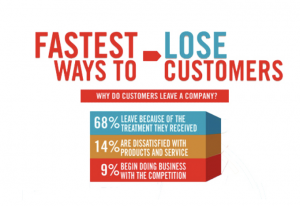As we head into the 3rd month of the first Quarter, we’re almost 25% of the way thru 2021.
The old saying goes:  “March comes in like a lion and goes out like a lamb”. Even though this compares the ‘bad’ weather to the lion, the Lion IS the King of the Jungle. And, in sales, I’d rather be in the “PRIDE” than slaughtered with the Lambs.
“March comes in like a lion and goes out like a lamb”. Even though this compares the ‘bad’ weather to the lion, the Lion IS the King of the Jungle. And, in sales, I’d rather be in the “PRIDE” than slaughtered with the Lambs.
Average Customer Loss
According to Marketing at Work, the average business loses about 10 to 25 percent of its customer base per year.  This doesn’t necessarily mean new customers aren’t replacing the old, but rather that repeat business is diminished and the company is spending time and money attracting new business. Customer attrition can be attributed to a number of different factors. If you’re in a highly competitive market and consumers have a number of options, your turnover may be higher simply because customers have many businesses to choose from. Even a slight difference in product, service, price or selection can sway customers in one direction or another.
This doesn’t necessarily mean new customers aren’t replacing the old, but rather that repeat business is diminished and the company is spending time and money attracting new business. Customer attrition can be attributed to a number of different factors. If you’re in a highly competitive market and consumers have a number of options, your turnover may be higher simply because customers have many businesses to choose from. Even a slight difference in product, service, price or selection can sway customers in one direction or another.
Keep Current Customers or Get New Ones?
Why not BOTH? But, be careful tho:
• It is 6-7x more expensive to attract a new customer than it is to retain an existing one.
• The probability of selling to an existing customer is up to 14x higher than the probability of selling to a new customer.
• If satisfied by the customer experience, 73% of consumers will recommend a brand to others, and 46% say they will trust that brand’s products and services above all others.
5 Steps to Selling the Solution
Below are 5 key points that may help you better align your messaging and book more meetings.
1. Consider the Customer’s Pain Points
Understanding your prospects’ business pain is key. The better your understand, the better your ability will be to service their needs. A customer may call in with a simple issue like, “I can’t access my wireless router.” A very simple answer could be “reset your router”. However, the same challenge could be the result of a larger business pain. Perhaps their wifi network isn’t producing a signal. This can lead to a considerable amount of lost productivity. It would only be through probing questions and simply inquiring as to the extent of the challenge that you can gain a better grasp of the prospects needs.
2. Engage, Then Inform
When first contacting your prospect, ensure your message targets the business pains the prospect is facing right at the beginning. You want to try to capture that person’s eye (or ear) right away whether it be via email, InMail or telephone. The goal is to encourage your prospect to read and/or hear more about what you have to offer.
3. Focus on Selling the Solution, not Products
A product or service sale results from solving a problem. Whether it be a person or a company, you don’t buy the bottle of vitamin water because you like the colour. You purchase it as a means to quench your thirst. The drink is a solution to being thirsty.
4. Highlight Your Differences
Just because your solution can solve their business challenge, it doesn’t mean you have the only solution on the market. You need to be able to position yourself against your competitors and convince the prospect that your solution is the best one. Be sure to highlight how you can help, your differences and be specific. Don’t make statements like, “We have the best customer service.” These statements mean little and are overused. Add some quantitative measures into your pitch. This could be a customer service rating or perhaps a link to the product reviews on Facebook or Yelp.
A better example is:
“We have 12 customers in the healthcare space and on average, each customer we have has been able to reduce their utility expenses by 54% with no capital cost. This is a tremendous savings.”
The other point to make is that even if there is is not a direct competitor to your solution, remember, there are indirect competitors and everyone is vying for a share of the budget.
5. Sell the True Value
We often recommend to customers that when building your value proposition, focus your attention on hitting core items that show a business value. We believe a solid value proposition needs to be underpinned on one or more of these four fundamental business drivers.
- Drive revenues
- Reduce expenses
- Create an efficiency
- Mitigate a risk
If you have pain in your business,  give Bullseye a call. We’re NOT going to just jam things downs your throat.
give Bullseye a call. We’re NOT going to just jam things downs your throat.
We have a 4-step process to help identify if we can even help:
STEP 1: Complete Needs Analysis – STEP 2: Identify & Define your Target Audience – STEP 3: Discuss & Set Realistic Expectations – STEP 4: Deliver, Follow-up & Support
At BMG, we do two(2) things well:
We GET you into the conversation or We KEEP you in the conversation
Because if they don’t KNOW you – they won’t BUY from you!
 “March comes in like a lion and goes out like a lamb”. Even though this compares the ‘bad’ weather to the lion, the Lion IS the King of the Jungle. And, in sales, I’d rather be in the “PRIDE” than slaughtered with the Lambs.
“March comes in like a lion and goes out like a lamb”. Even though this compares the ‘bad’ weather to the lion, the Lion IS the King of the Jungle. And, in sales, I’d rather be in the “PRIDE” than slaughtered with the Lambs. This doesn’t necessarily mean new customers aren’t replacing the old, but rather that repeat business is diminished and the company is spending time and money attracting new business. Customer attrition can be attributed to a number of different factors. If you’re in a highly competitive market and consumers have a number of options, your turnover may be higher simply because customers have many businesses to choose from. Even a slight difference in product, service, price or selection can sway customers in one direction or another.
This doesn’t necessarily mean new customers aren’t replacing the old, but rather that repeat business is diminished and the company is spending time and money attracting new business. Customer attrition can be attributed to a number of different factors. If you’re in a highly competitive market and consumers have a number of options, your turnover may be higher simply because customers have many businesses to choose from. Even a slight difference in product, service, price or selection can sway customers in one direction or another.
 317-289-4965
317-289-4965

 give Bullseye a call. We’re NOT going to just jam things downs your throat.
give Bullseye a call. We’re NOT going to just jam things downs your throat.